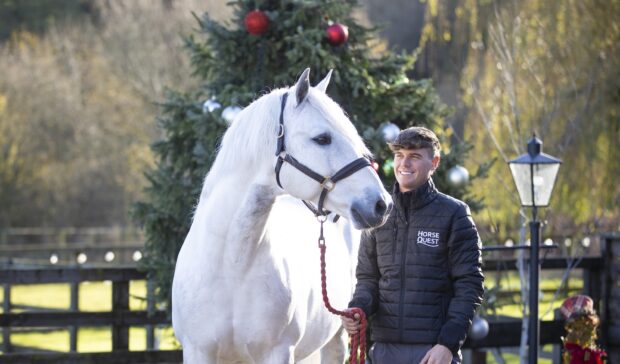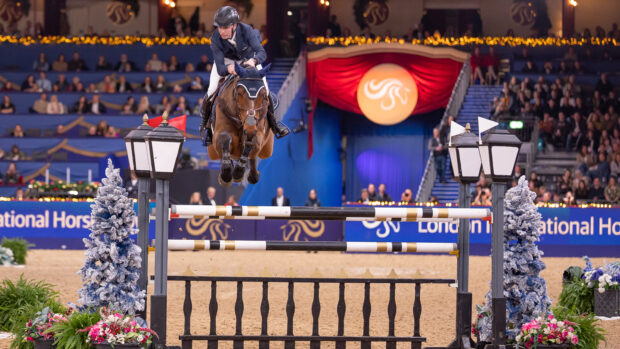A pony who could barely walk as all four pedal bones were threatening to emerge through his soles is now fit and happy and in full work.
Alex Aungier’s Welsh Section A Friars Gold Fever was struck by acute laminitis two years ago. Now rising 19, he’s fit and well, goes out for full days’ hunting with Alex’s daughter Gracie, and is “like a four-year-old”.
Alex told H&H “Flash” was sound, happy and healthy one day, then barely able to walk the next.
“It was so sudden; Gracie had been jumping him the day before and he was absolutely fine,” Alex said. “At that point, I didn’t know anything about laminitis; I thought it was a disease fat ponies got from grass and that was all I knew. But I’ve since learned it’s often secondary to another issue; it turned out he had [equine metabolic syndrome] EMS and Cushing’s. Normal insulin levels are 12 to 20 and his were 375. And by the time you start seeing the signs of laminitis, the damage is already done.”
Alex called the vet and had X-rays done, which showed that all four pedal bones were rotated at least 11 degrees. The hind feet were worse; one was rotated by 14 degrees.
“His near hind was pointing straight down, millimetres from his sole,” Alex said. “It was desperate times.”
Under a farrier who specialises in laminitics, Flash made slow but steady progress, as his feet were redmodelled and supported. He was trimmed and X-rayed every four weeks, and on box rest for months.
“He was such a good patient,” Alex said. “Absolutely brilliant all the time. I was trying to manage his EMS but the treatment he was having was being counteracted by the Cushing’s. So because we weren’t treating the cause, the laminitis wasn’t getting better. But my vet tested him, found he had Cushing’s and then we could treat him.”
Alex said that with hindsight, she has realised the trigger of the laminitis was some rye grass haylage Flash had in December.
“I’ve since found out that’s a complete no-no for EMS, and that’s what must have pushed him over the edge,” she said.
“Months in, he looked better; his feet were growing beautifully and he had reverse aluminium plates to support his frogs, still being trimmed every four weeks, and by November 2021 we thought we were getting there. We hoped we could get him pasture sound, then by January we thought he might be up to light hacking. In August last year, he did a Horse of the Year Show working hunter qualifier and came third.”
Flash is now carefully managed and on medication but he is able to live a normal and happy life, turned out in a herd and enjoying himself with Gracie, out with the Surrey Union.
“He’s amazing, he’s my boy,” Alex said. “Of all the ponies, and I love them all dearly, he’s the apple of my eye. He’s the kindest, sweetest, nicest boy and he and Gracie have such a partnership; he loves her and she loves him.
“After four and a half hours with the Surrey Union last weekend, they passed me, him cantering sideways and pulling her arms out, looking like a four-year-old. When I look back at those horrible days – he will be with us for ever.”
Alex urged anyone in a similar situation to understand what is involved.
“With laminitis you have to have deep pockets, time and patience,” she said. “It takes a year for the foot to grow out, and even when they look sound, don’t take things too quickly. It’s important to X-ray because if you don’t, you’re blind to what’s going on. People need to understand that laminitis is often secondary to something else.
“Throughout the whole thing, there was never a point I thought Flash had had enough; it was more a ‘Help me’ than ‘I’m done, Mum’. We are over the moon. He’s my boy and he’s never leaving us.”
British Equine Veterinary Association veterinary projects manager Lucy Grieve told H&H: “Flash’s story is an incredible one, which highlights what an awful condition laminitis is for everyone involved. He is lucky to have recovered to the extent he has, as so many do not despite owners’, vets’ and farriers’ best efforts. Sadly, many horses and ponies are living on the knife-edge of developing laminitis, without their owners knowing what could be round the corner. By making others aware of Flash’s lucky escape, Alex is helping others learn about the causes of laminitis and how to avoid it where possible.
“As Alex highlights, laminitis usually occurs as a result of having high insulin levels, which can occur with Cushing’s Disease (PPID), EMS, when a horse is overweight, a high starch and sugar diet or any combination of these factors. By keeping horses at a healthy weight and checking for PPID and high insulin, we can hopefully minimise the number of horses who succumb to laminitis and suffer its terrible effects.”
You might also be interested in:

Laminitis: how to spot the signs, plus treatments and ways to prevent it

Managing equine metabolic syndrome
Veterinary advice on managing the hormonal condition which leads to equine obesity and laminitis

Subscribe to Horse & Hound magazine today – and enjoy unlimited website access all year round
Horse & Hound magazine, out every Thursday, is packed with all the latest news and reports, as well as interviews, specials, nostalgia, vet and training advice. Find how you can enjoy the magazine delivered to your door every week, plus options to upgrade your subscription to access our online service that brings you breaking news and reports as well as other benefits.




